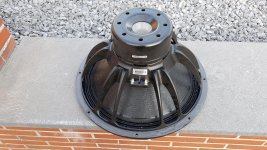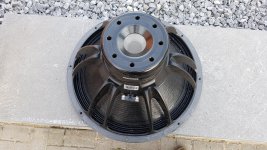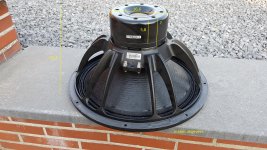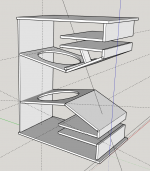Hey,
can you take a look at my design?
it is a D&B B22, in my opinion there is original a B&C 18SW115, 8 ohm, 18 inch in the case. (maybe Custom one)
Do you happen to know if that info is correct?
Now I saw that there is a new speaker from B&C.
namely the B&C 18DS115, 8 ohm, 18 inch
according to the B&C site, this would be an improved version.
Can I order and install it?
Or better buy the 18SW115, because that's what the speaker cabinet is designed for.
Remy Kallen.
can you take a look at my design?
it is a D&B B22, in my opinion there is original a B&C 18SW115, 8 ohm, 18 inch in the case. (maybe Custom one)
Do you happen to know if that info is correct?
Now I saw that there is a new speaker from B&C.
namely the B&C 18DS115, 8 ohm, 18 inch
according to the B&C site, this would be an improved version.
Can I order and install it?
Or better buy the 18SW115, because that's what the speaker cabinet is designed for.
Remy Kallen.
Attachments
Remy,
I don't know if the D&B B22 uses an actual B&C 18SW115, or an OEM driver that looks similar.
The B&C 18DS115 had not been released in 2016 when the D&B B22 was.
Although the B&C marketing department says the 18DS115 "high energy subwoofer is a significant step forward from similar models in the B&C range", though it has a longer aluminum voice coil, it actually has less Xvar than the 18SW115, and a number of TS parameters different from the 18SW115 that may not be an improvement in the big bandpass box.
I've yet to hear any reports of actual comparisons of the different drivers in the same box. B&C shows the 18DS115 in a smaller box with a higher tuning on the data sheets.
I don't know if the D&B B22 uses an actual B&C 18SW115, or an OEM driver that looks similar.
The B&C 18DS115 had not been released in 2016 when the D&B B22 was.
Although the B&C marketing department says the 18DS115 "high energy subwoofer is a significant step forward from similar models in the B&C range", though it has a longer aluminum voice coil, it actually has less Xvar than the 18SW115, and a number of TS parameters different from the 18SW115 that may not be an improvement in the big bandpass box.
I've yet to hear any reports of actual comparisons of the different drivers in the same box. B&C shows the 18DS115 in a smaller box with a higher tuning on the data sheets.
The DS has a significantly more motorstrength, it is a diffrerent solution compared to the SW, not sure if part of the difference in Bl stems from that the SW has a variable winding density to flatten the Bl curve and the DS does not, either way, being a SW user my self (15") I could not be happier, very detailed and precise low end, perhaps the DS is even more of the same, but the results are of course also hugely impacted by the loading type (enclosure).
The 18DS115 is rated for the same power as the 18SW115, and has only slightly more Xmax, but less Xvar.
6 dB louder would require double the displacement, could you show the sims?
A resonator design attenuates membran excursion. The limiting factor for Max. SPL ceases to be speaker displacement, but rather motor strength and electrical / thermal capability.
Understanding the basic underlying principles would seem to be a necessity before conceiving, much less publishing a speaker plan.
Regarding the OP: copying a plan off a commercial product and loading it with an arbitrary driver is probably not the best idea. What I can definitely tell you, from practical experience as well as dedicated measurements, is that a port area of ~400cm², 1/3 sd, in combination with high performance woofers, will not make you very happy. Keywords "compression", "flow loss".
Stoneeh, cone excursion is generally reduced in a fairly narrow bandwidth, or maybe two or three areas for higher-order bandpass designs. You still need Xmax to make up the gaps in-between.
FWIW, I've designed, built and measured cabinets as you've described. They make me happy. More importantly, they also make my customers happy, which means I get paid.
Chris
FWIW, I've designed, built and measured cabinets as you've described. They make me happy. More importantly, they also make my customers happy, which means I get paid.
Chris
A blanket statement of "double max excursion = +6 dB Max. SPL" for a resonator design is still inaccurate at best. If it will, an excursion limitation will happen within a narrow frequency band - though it might not, depending on the woofer as well as the enclosure.
I have done plenty of Max. SPL measurements on resonator boxes (bassreflex, tapped horn, ...), and some combinations will indeed be electrically limited across the whole frequency range. It's not at all unusual.
As for a resonator's supposed narrow influence, that is only partially true.
I'll add a quick illustration. In blue you can see the frequency response of a bassreflex tuned at 32 Hz with a large port; in green the same box with the port closed. In black I've also added the near field response of the port.
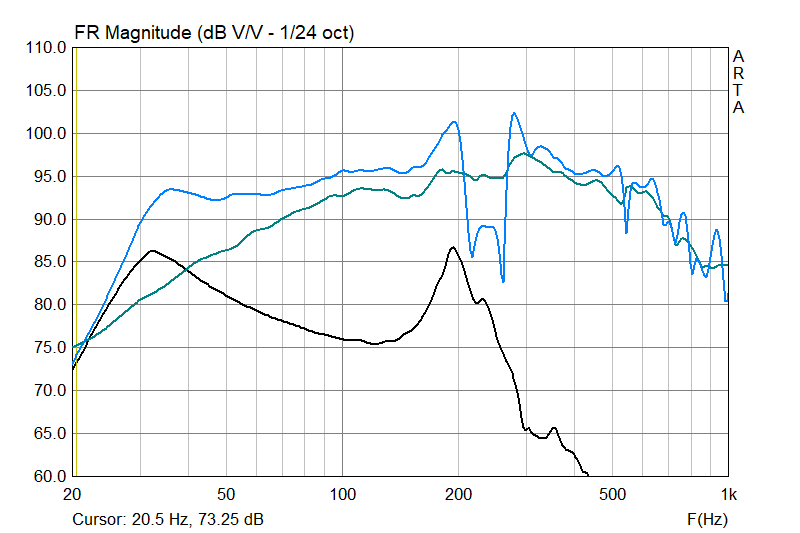
We see the expected narrow peak at the resonator's tuning, but the resonator loads and adds to the sensitivity of the bassreflex design basically through the whole bass range. As resonator loading equates to speaker excursion attenuation, there's also that.
I would put out a general recommendation for everyone to put the required effort into attaining their facts, and reserve judgement, let alone advice, until then. Speculation and heresay doesn't benefit anyone, and even simulations, especially simple ones, like with WinISD or HornResp, are just approximations and should be taken with a grain of salt.
I have done plenty of Max. SPL measurements on resonator boxes (bassreflex, tapped horn, ...), and some combinations will indeed be electrically limited across the whole frequency range. It's not at all unusual.
As for a resonator's supposed narrow influence, that is only partially true.
I'll add a quick illustration. In blue you can see the frequency response of a bassreflex tuned at 32 Hz with a large port; in green the same box with the port closed. In black I've also added the near field response of the port.

We see the expected narrow peak at the resonator's tuning, but the resonator loads and adds to the sensitivity of the bassreflex design basically through the whole bass range. As resonator loading equates to speaker excursion attenuation, there's also that.
I would put out a general recommendation for everyone to put the required effort into attaining their facts, and reserve judgement, let alone advice, until then. Speculation and heresay doesn't benefit anyone, and even simulations, especially simple ones, like with WinISD or HornResp, are just approximations and should be taken with a grain of salt.
Stoneeh,1)A blanket statement of "double max excursion = +6 dB Max. SPL" for a resonator design is still inaccurate at best.
2)I have done plenty of Max. SPL measurements on resonator boxes (bassreflex, tapped horn, ...), and some combinations will indeed be electrically limited across the whole frequency range.
3)As for a resonator's supposed narrow influence, that is only partially true.
4)We see the expected narrow peak at the resonator's tuning, but the resonator loads and adds to the sensitivity of the bassreflex design basically through the whole bass range. As resonator loading equates to speaker excursion attenuation, there's also that.
5)I would put out a general recommendation for everyone to put the required effort into attaining their facts, and reserve judgement, let alone advice, until then. Speculation and heresay doesn't benefit anyone, and even simulations, especially simple ones, like with WinISD or HornResp, are just approximations and should be taken with a grain of salt.
I agree with all 5 of your points above, and have put considerable time and effort in attaining facts through careful, repeated measurements.
You may be interested in the actual excursion measurements taken between the BC 18SW115-4 in the Keystone TH and a bass reflex enclosure, both with an Fb of 37Hz, as posted in the OP of this thread:
Keystone Sub Using 18, 15, & 12 Inch Speakers
Taken "with a grain of salt", simulations of the Keystone design using the BC 18SW115 vs. the 18DS115 would appear the 18DS115 requires nearly double it's rated power to reach Xmax, so it's SPL would indeed be electrically limited across the whole frequency range, while the 18SW115 reaches Xmax at approximately rated power, conservatively reaching the stated levels, which in light of some of our discussions, may be 3dB (or more..) understated.
Your tests using an inexpensive low power/excursion driver in the SS15 makes me wonder what the 10% distortion limited output of the BC 18SW115 in the Keystone would be, as 10 years ago I had no amplifier capable of the voltage required to push the driver to that level of distortion.
Cheers,
Art
Last edited:
Interesting.
Stoneeh: In the graph posted in your last post, My Decibel math does not compute. If you add those two sources, I don't see how the outcome is right. Pick 100Hz and add/sum those decibels. The outcome should absolutely NOT give you +2.5 or +3dB.
Weltersys: Carefully with power. Impedance and phase differences might lead you on believing in that.
Stoneeh: In the graph posted in your last post, My Decibel math does not compute. If you add those two sources, I don't see how the outcome is right. Pick 100Hz and add/sum those decibels. The outcome should absolutely NOT give you +2.5 or +3dB.
Weltersys: Carefully with power. Impedance and phase differences might lead you on believing in that.
+1 for crashpc.
The graph of Stoneeh is not very accurate, max. addition of two sources with the same signal in phase is +6db also, where the two plots are crossing its more like +9db.
18ds115 is more efficient and actually needs less power than 18sw115 in any design but needs more voltage for the same output.
after testing a lot with the 21ds115-4 in bassreflex subwoofer my opinion is that the ds series is advanced over the sw series in therms of total efficiency or required enclosure volume but won't have more maximum output because when you drive them really hard (>1500W) they run out of juice and the sw series catches up.
The graph of Stoneeh is not very accurate, max. addition of two sources with the same signal in phase is +6db also, where the two plots are crossing its more like +9db.
18ds115 is more efficient and actually needs less power than 18sw115 in any design but needs more voltage for the same output.
after testing a lot with the 21ds115-4 in bassreflex subwoofer my opinion is that the ds series is advanced over the sw series in therms of total efficiency or required enclosure volume but won't have more maximum output because when you drive them really hard (>1500W) they run out of juice and the sw series catches up.
- Home
- Loudspeakers
- Subwoofers
- B&C 18SW115 or B&C 18DS115 ?
